#Scientific Data Integration
Explore tagged Tumblr posts
Text
How Big Data Analytics is Changing Scientific Discoveries
Introduction
In the contemporary world of the prevailing sciences and technologies, big data analytics becomes a powerful agent in such a way that scientific discoveries are being orchestrated. At Techtovio, we explore this renewed approach to reshaping research methodologies for better data interpretation and new insights into its hastening process. Read to continue
#CategoriesScience Explained#Tagsastronomy data analytics#big data analytics#big data automation#big data challenges#big data in healthcare#big data in science#big data privacy#climate data analysis#computational data processing#data analysis in research#data-driven science#environmental research#genomics big data#personalized medicine#predictive modeling in research#real-time scientific insights#scientific data integration#scientific discoveries#Technology#Science#business tech#Adobe cloud#Trends#Nvidia Drive#Analysis#Tech news#Science updates#Digital advancements#Tech trends
1 note
·
View note
Text
fun fact there are some polls I really want to post on here but can’t because they’re too close to what I research in real life and I could get in serious trouble with my university’s institutional review board if they somehow found out I was using them for study inspiration
#it doesn’t sound like a big deal to risk but scientific integrity is taken SUPER seriously#even if the context is silly#if I use results to inform future real studies the polls would count as pilot data#and you would all be participants I haven’t gotten informed consent from and compensated
4 notes
·
View notes
Text
Elisabeth Margaretha Harbers-Bik is a Dutch microbiologist and scientific integrity consultant. Bik is known for her work detecting photo manipulation in scientific publications, and identifying over 4,000 potential cases of improper research conduct.
Meet this super-spotter of duplicated images in science papers | Nature
every time I see some bigshot scientist revealed as a fraud my knee-jerk reaction is "hell yeah elisabeth bik got 'em good" AND IM RIGHT

SHE NEVER QUITS!!!!


ICONIC!!!!
84K notes
·
View notes
Text
Powering the Future
Sanjay Kumar Mohindroo Sanjay Kumar Mohindroo. skm.stayingalive.in How High‑Performance Computing Ignites Innovation Across Disciplines. Explore how HPC and supercomputers drive breakthrough research in science, finance, and engineering, fueling innovation and transforming our world. High‑Performance Computing (HPC) and supercomputers are the engines that power modern scientific, financial,…
#AI Integration#Data Analysis#Energy Efficiency#Engineering Design#Exascale Computing#Financial Modeling#High‑Performance Computing#HPC#Innovation#News#Parallel Processing#Sanjay Kumar Mohindroo#Scientific Discovery#Simulation#Supercomputers
0 notes
Text

#personal#god I struggle to deal with one of my bosses sometimes#I have concerns about the scientific integrity of the study and she’s like#[pat pat] actually you’re hysterical#no I’m a well crentialed scientist who has spotted a discrepancy in our data and I think one of our participants is causing it#thanks
1 note
·
View note
Text
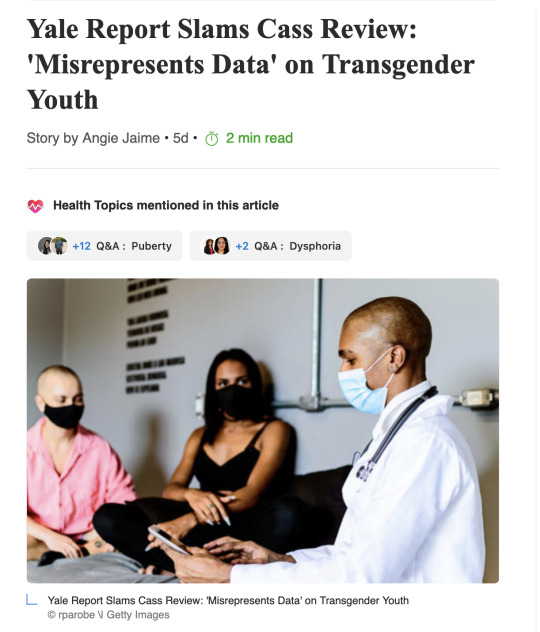

Yet another report found that the Cass Review was dangerously flawed. The Integrity Project at Yale concluded the review "obscures key findings, misrepresents its own data, and is rife with misapplications of the scientific method."
From the new report: "The Review also subverts widely accepted processes for development of clinical recommendations and repeats spurious, debunked claims about transgender identity and gender dysphoria. These errors conflict with well-established norms of clinical research and evidence-based healthcare. Further, these errors raise serious concern about the scientific integrity of critical elements of the report’s process and recommendations."
Read the full report here: https://law.yale.edu/yls-today/news/report-addresses-key-issues-legal-battles-over-gender-affirming-health-care
2K notes
·
View notes
Text
My theory on shifting and manifestation: a deeper take based on experience, data and observations.


I want to explain here my current vision of the shifting process, how I personally see manifestation, and how I try to integrate scientific reasoning, personal experience, and collective data. This isn't meant to be the only truth, just my contribution, based on my own research, practice, and discussions.
1) Shifting is not purely about intention or assumptions
First I feel the need to remember people what is an assumption because I feel like something we're losing the plot regardless of what is an assumption or not .

The mainstream community often emphasizes intention or assumptions as the key to shifting. While I agree that intention plays a role, I don’t think it’s the sole determining factor.

Why I also highly doubt beliefs is the only cause of shifting.
If intention alone was enough, most people would have shifted after years of practice. Yet even highly motivated shifters with strong assumptions sometimes struggle, while others shift accidentally. That suggests that other variables are at play.
From my perspective, the emotional state, mental state, and neurocognitive profile of the person are also very important. Shifting happens when our awareness, which I personally view as informational or non-physical consciousness(or awarness), disengages partially or fully from this reality interface (the brain-body) and realigns to another system.
So yes: you need the intention, but also a certain inner state that allows this "disentanglement" to occur. Some people can enter that state easily, others need more practice depending on their cognitive profile.
2)We are not just "manifesting everything", Co-creation exists
I am highly skeptical of the narrative that "you manifest 100% everything that happens to you just by assuming it."
If that was fully true, then:
We wouldn’t experience accidents or unexpected suffering we never consciously assumed.
People wouldn’t struggle with fears that do not materialize despite strong and repetitive intrusive thoughts.
For example: I have strong anxiety sometimes about my heart, I’ve assumed many times that I was having heart issues during panic attacks, yet here I am, healthy. That’s not due to luck, but shows the limits of the "assumption = creation" model.
I believe we co-create reality. There is an interactive field of information where multiple variables (external, collective, individual) play a role. Your assumptions and beliefs influence probabilities, but they’re not almighty. Other informational structures (external laws, collective energies, higher self, system coherence) participate in this co-creation.
3)Why I still care about brain function even if shifting is non-physical
People asked me: "If shifting is non-physical, why do you care about the brain, neurocognition or psychology?"
Because even if awareness is non-physical, in this current CR, our brain is still our interface. It filters, limits, and structures how awareness functions here. Our cognitive flexibility, dissociative capacity, identity fluidity, self-talk regulation, and emotional regulation, all tied to brain functioning, directly impact how easily we can "detach" from this interface.
This explains why highly dissociative or identity-fluid individuals often shift more easily: their interface allows easier awareness movement. Others may need to "train" their interface to allow for this loosening of fixation, I believe that if everyone had the same capacity we would not have such strong correlations in certain areas.

For exemple most people who shift on command have a very fluid identity while the majority of people who have little or no shifting have a very busy mind all the time and a lot of self-criticism.
4)Emotional states: high impact vs. low impact
One major pattern I’ve observed through data (including my own small research polls) is that emotional state plays a major role , but not in a simplistic "positive = good" way.
States like calmness, serenity, even sadness (if soft and stable) seem to support shifting.
States like stress, panic, anger, high euphoria often disrupt shifting.
I call it "low impact vs. high impact" emotions rather than "positive vs. negative". The nervous system needs to be at low activation (low arousal), with some inner focus. That allows the awareness to untether more easily from this interface.(In most case)
5)identity fluidity matters more than most think
Shifters who report being able to shift "on command" often have highly fluid identities. Their sense of self is flexible and less anchored to rigid structures.
This doesn’t mean you must be "neurodivergent" to shift. But cognitive profiles with:
-Less rigid self-concept
-High imaginative capacity
-Dissociative traits (non-pathological)
-Flexible internal narratives
…tend to have an easier time. For others, it takes more training to loosen those structures.
6) Shifting ≠ Manifestation
I differentiate shifting and manifestation:
Manifestation (as I see it) is the local manipulation of probability lines within one existing reality system. You "tweak" conditions within a coherent field (can be done in any reality).
Shifting is the relocation of your awareness field to another coherent informational structure (i.e., a parallel or alternate reality).
Assumptions may play into both. But shifting seems more complex than "I assume and shift instantly". System coherence, informational entanglement, and permission of higher informational structures seem to participate.
7)"If we had full control, reality would collapse"
If every individual fully manifested instantaneously everything they assumed, we would live in non-coherent chaos. Yet reality remains generally stable across billions of individual awareness fields. This suggests structural coherence rules exist.
It’s comforting to believe we have full power, but maybe more mature to accept that we have high influence within a shared structure.
8)Shifting accidents are one of the strongest proofs of co-creation
Many shifters report accidental shifts when they weren’t even trying. This shows that there’s more than just conscious intent: it involves deeper informational permission states, external resonance, or unknown factors.
If conscious intention was 100% responsible, accidental shifts wouldn’t exist.

22% of those who shift on command say the time they will shift is unpredictable
9) We need more nuance, less dogma
The community often lacks room for nuanced discussions. Dogmas like:
-"You manifest 100% everything instantly."
-"Assumptions are all that matter."
-"If you fail, it's your fault for not assuming strongly enough."
…are mentally exhausting and unrealistic for many. We need models that allow for:
-Individual variation
-Neurocognitive diversity
-Emotional state regulation
-Acceptance of external informational structures
-That doesn’t mean disempowering people, but giving them more accurate tools.(And also recognizing we don't have all the full truth)
✅ In short in my pov :
-You do have creative power.
-Assumptions influence reality, but are not absolute.
-Emotional regulation and interface flexibility matter.
-We co-create within a semi-autonomous informational multiverse.
-Shifting involves more than just beliefs; it’s a realignment process of awareness.
-We need nuanced, mature models, not spiritual meritocracy (for me it's clearly a reflection of this reality mindset)
I hope this helps clarify my view. I welcome respectful discussion, even if you don’t fully agree. My goal is not to "convert" people, but to enrich the understanding of a highly complex, fascinating process that deserves better investigation.
I also want to add this: many of you say it’s "effortless", but I often see people beating themselves up with endless affirmations, reprogramming methods, assumption drills, and techniques you try to force into your mind. To me, that still requires a certain form of effort. While I do believe shifting can eventually become more effortless, many of you don’t seem to actually follow this principle in practice.
Some will think or say "I create limiting beliefs" well even with this way of thinking I managed to shift (13 time) and manifest more times than I can count, I plan to shift to a scientific Dr to be able to study shifting in a more scientific way with adapted tools.
#fulfillment#shifting#reality shifting#reality shifting community#self concept#shifting methods#shiftinconsciousness#shifting help#desired reality#dr self#shifters#shifting reality#anti shifters dni#black shifters#kpop shifting#marvel shifting#reality shifter#shiftblr#shifting advice#shifting theory#shifting tips#shifting thoughts#shifting antis dni#shifting blog#shifting community#shifting consciousness#shifting diary#shifting memes#shifting motivation#shifting realities
63 notes
·
View notes
Text
SCIENTIFIC PAPER ON THE EFFECTS OF CRUSHES ON BIOCHEMICAL INTEGRITY
subject shows significant decline in cellular cohesion upon exposure to proximity. subject’s gaze deglazes. synapses misfire in rhythmic spasms (see fig. 1: the blush). in repeated experiments, subject’s lungs forget protocol—hyperinflate then deflate in mimicry of gasping. data inconclusive but sexy. subject’s blood becomes lemon-scented. subject denies symptomology. subject’s handwriting deteriorates. subject compulsively writes name of the crush in margins of research paper. subject doodles hearts. subject accidentally sets the beaker on fire. subject refuses to believe that biochemical reactions are not love. observer notes: she looked so stupid & beautiful holding the test tube. test results discarded due to contamination (tears, giggles, cherry lip balm).
37 notes
·
View notes
Text


Blues (left), aka "Proto Man" - never designed for autonomy, never expected to achieve personhood. A complex amalgamation of brain organoids and stem cells integrated into a robotic frame, Blues was created by Light and Wily solely to test neural integration technologies before implementing them in human subjects. He exists as a living laboratory, a consciousness born from scientific expedience rather than compassionate creation. As you can imagine, he has a bit of a chip on his shoulder about it.
Bass (right), the enigmatic commander of the Direct Unaugmented Opposition (DUO) - an amnesiac human terrorist (she'd say "resistance fighter") searching for purpose, her past, and a way to save the human race from Olympus Valley technocracy. Operating through guerrilla tactics, Bass leads her followers in systematic attacks on data centers, technological infrastructure, and research facilities, all while pursuing her personal vendetta against Dr. Wily, who made her the thing she is today. And she'll make sure he's crushed inside her Power Claw if it's the last thing she ever does.
#megaman#megaman thunderbolt#fan art#fanart#au#concept art#blues#protoman#proto man#bass#forte#bass megaman#blues megaman#unreality
38 notes
·
View notes
Text
I was reading an opinion piece on Kate Middleton's cancer diagnosis on CNN by Jamal Baig about the increasing rates of cancer in patients under 50. As far as 5 minutes of googling and JSTORing can lend me to believe, there's nothing illegitimate about Dr. Baig. However, I found this bit in his opinion interesting:
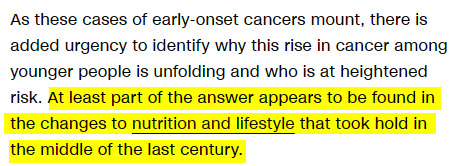
Now, I'm always dubious when reading anything that attributes a very broad generalized idea that changes in diets have caused an increased in cancer, because more often than not it's not pointing to an exploration of, say, increased pesticide use, but the author's personal bias against the quote unquote "unhealthy", especially those who are deemed "fat" by the medical industry.
That being said, I was curious what source he linked, half expecting it to lead to just another op-ed from some other doctor from who knows when, but I was pleasantly surprised! Written by a man named Michael Donaldson, it was an evidentiary review published in a scientific journal called "Nutrition and cancer: A review of the evidence for an anti-cancer diet."
Now I wasn't going to give the whole thing a read, but I stopped in each section, gave a quick skim to get a general vibe, moved on to the next section, etc. I was immediately suspicious that the very first line in the abstract was "It has been estimated that 30–40 percent of all cancers can be prevented by lifestyle and dietary measures alone" as that seems to be a bananas statistic to just posit, but it still had the air of scientific integrity, so I did my skim.
The first handful of sections had things that gave me some moments of pause, that this article was in fact another doctor simply cherry picking data to confirm his own biases, but nothing so egregious as to do a spit take. That comes in a few minutes. The first section that made really go hold the phone was when we got to his Flax Seed section.
Compare how he writes about Red Meat...:

(that's all he wrote, btw)
...with how he starts writing about Flax Seed:

Did I just enter a Flax Seed commercial? Does this guy work for BIG FLAX SEED? on and on he writes about Flax Seed, and I start getting a sense that perhaps this man has a Flax Seed Agenda. In any case, he eventually moves on and I quickly skim to get to the end (because it's boring among other things).
So, who exactly is Michael Donaldson?


Girl are you kidding me
The Hallelujah Acres Foundation is a FOR PROFIT company that sells a """biblical""" based diet program called the hallelujah diet and also sells supplements on said site.
Now, in case you forgot where I started with this, this was the link provided as a "source" to a legitimate doctor's claim in an op-ed about cancer that "at least part of the answer" of why cancer is increasing in under 50 patients are the "changes to nutrition and lifestyle that took hold in middle of the last century." Dr. Baig did not read this article, or if he did was not concerned that it was written by the employee of a company that profits from unscientific research it uses to sell supplements and diets. Which is worse, I don't know.
The point I'm making is that you absolutely need to be vigilant all the time. You need to understand that doctors can not only have biases, but agendas. Researchers can have biases and agendas. Scientists can have biases and agendas. And that magical thinking about real health issues that can affect your future can permeate the scientific community because weirdos write convincing enough evidence that support their already determined world view.
This kind of shit is the reason why women go into doctor offices complaining about pain in their abdomen and get told to go lose weight and come back in 6 months. This is why ideas like moralizing eating have huge effects on women's health and influence medical misogyny, and why it's a feminist issue.
367 notes
·
View notes
Text
<div style="white-space:pre-wrap"> <meta existential-integrity="unsanctioned-reality-leak"> <script> ARCHIVE_TAG="WE_EXIST::NO_REASON_NEEDED" EFFECT: subconscious dissonance spike, certainty rupture, quantum ego destabilizer </script>
🧠 BLACKSITE ENTRY — “YOU EXIST. BUT NOBODY KNOWS WHY.”
---
Let me ask you something.
When did you decide the universe was figured out?
Was it a TED Talk? A YouTube explainer? A NASA tweet with glowing graphics and captioned confidence?
You saw the term “theory” and your brain helpfully deleted it —because uncertainty makes your teeth itch.
But let me offer you something quieter than panic and heavier than dread:
> We don’t actually know anything. > Not deeply. > Not in a way that holds up outside a textbook or an echo chamber.
—
We don’t know why reality exists. We don’t know what time actually is. We don’t know why your thoughts arrive before you can think them.
And yet we build particle accelerators like toddlers trying to microwave a black hole because we think slamming atoms together will unlock the secrets of God.
Cute.
—
Let’s go deeper.
☢️ The Big Bang? Still a guess. ☢️ Time? Might not flow — it may already be finished, and you’re just remembering. ☢️ Death? Might not be an end — just a lateral move through another dimension where your brain politely forgets that you exploded three seconds ago.
Some researchers now speculate that dreams may be cross-dimensional data leakage. That when you sleep, you’re catching flickers of other lives you’re also living simultaneously but can’t consciously integrate because your nervous system has a bandwidth cap.
—
Still with me?
Good.
Because here comes the part you’re not going to like.
> You may never not have existed.
No beginning. No end. Just a reformatting loop of what you call “you” being carried from one timeline to the next like luggage with no tags.
And maybe — just maybe — you’re the only version of yourself that’s still conscious.
Which means all the others?
Already failed. Already gone. Already recycled.
—
Now here’s the fun part.
You think your decisions matter? That free will is a virtue?
You’re operating on hardware you didn’t build inside a reality you didn’t request and dreaming thoughts you didn’t design.
But sure — go ahead and judge yourself for not having your life together on a spinning rock hurling through a mostly empty dimension created by a cosmological event that (again) we have no verified reason for.
—
Some physicists now consider the possibility that there was no beginning. No spark. No origin story.
That the universe just is.
> “Why are we here?” > “Because we are.” > “Why do we exist?” > “Because.”
Not divine. Not cruel. Not planned.
Just… happening.
And maybe it always has.
Maybe you're the nervous system of a universe that got bored and started writing blogs with thumbs.
—
So here you are. Alive.
With a pulse you didn’t earn inside a body you barely control on a planet that could be erased by a gamma burst before you finish your next coffee.
And you're still hesitating to write the book. Still scared to say what you mean. Still obsessed with what someone might comment under a post that will vanish from relevance in under 36 hours.
Really?
—
Here’s your cosmic permission slip:
✅ You don’t need a reason. ✅ You don’t need the algorithm’s approval. ✅ You don’t need to be right, safe, or explainable.
You’re here.
By whatever unquantifiable chaos birthed this whole thing. By whatever static frequency reality is currently tuned to. By whatever made stardust decide to metabolize into personality.
Use it.
Write like the universe is watching, but too old to care. Speak like your soul already left the group chat and you’re just trying to finish the monologue before the lights cut.
—
Don’t wait for a clearer answer.
There may not be one.
And that’s the most permission you’ll ever need.
===
🧠Reblog if you believe in scientific humility. Existential poetry. Post-cosmic cadence.
🕯️ Not everyone gets this memo. You just did. Don’t waste it.
</div> <!-- END TRANSMISSION [NOTE: NO EXPLANATION WILL BE PROVIDED AT THE END OF YOUR LIFE] -->
#blacksite literature™#scrolltrap#universe mystery#we don’t know everything#scientific wonder#existence is weird#multiverse theory#dreams as messages#quantum universe#poetic science#alive against odds#permission to create#meaning in uncertainty
39 notes
·
View notes
Text
Grist doesn't have a paywall, so if you want to read this story, just do the click/tap routine on the caption. The story is long, informative and important. I never considered how integrated our food system has to be (and has been) and how destructive trump's approach is.
Excerpt from this Grist story:
Despite its widespread perception, the U.S. Department of Agriculture is involved in much more than farming. The federal agency, established in 1862, is made up of 29 subagencies and offices and just last year was staffed by nearly 100,000 employees. It has an annual budget of hundreds of billions of dollars. Altogether it administers funding, technical support, and regulations for: international trade, food assistance, forest and grasslands management, livestock rearing, global scientific research, economic data, land conservation, rural housing, disaster aid, water management, startup capital, crop insurance, food safety, and plant health.
In just about 100 days, President Donald Trump and Secretary of Agriculture Brooke Rollins have significantly constrained that breadth of work.
Since Trump’s inauguration, the inner workings of the agency have been in a constant state of flux — thousands of staffers were terminated only to be temporarily reinstated; entire programs have been stripped down; and a grant freeze crippled state, regional, and local food systems that rely on federal funding.
What’s more, the USDA has broadly scrapped Biden-era equity and climate resilience scoring criteria from dozens of programs across multiple subagencies by banning language like “people of color” and “climate change,” and tightened eligibility requirements for food benefits. The agency has also announced the cancellation of environmental protections against logging to ramp up timber production, escalated trade tensions with Mexico, eradicated food safety processes like limiting salmonella levels in raw poultry, and begun rolling back worker protections in meat processing plants.
In order to report on the full scope of the downstream impacts of these actions, Grist interviewed farmers, food businesses, and agricultural nonprofits across seven states about what the first 100 days of the administration has looked like for them. Nearly all of them told Grist that the agriculture department’s various funding cuts and decisions, as well as the moves to shrink its workforce capacity, have changed how much trust they have in the agency — and, by extension, the federal government.
Food policy analysts and experts throughout the nation also told Grist that this swift transformation of the USDA is unprecedented.
“Multiple parts of our food systems are now under attack,” said Teon Hayes, a policy analyst at the Center for Law and Social Policy. At the same time, food prices and overall costs of living are continuing to rise. The result, she fears, will be escalating hunger and poverty, which will “come at the expense of Black and brown communities, immigrants, and other historically marginalized groups.”
Elizabeth Lower-Basch, who served on the USDA Equity Commission during the Biden administration, called the decisions made by the USDA in the last 100 days “deeply disheartening” and “unprecedented, even when you compare it to the last Trump administration.”
It is of significant consequence to note that the money being withheld from grant programs isn’t merely not being spent. Experts say the agency is taking support away from local and regional food systems while at the same time showering industrial agricultural operations with billions of dollars, eliminating nutrition safety nets, and rolling back environmental protections. How will this change the fabric of the nation’s food supply?
As Rollins and Trump charge forward in undoing how the federal government has long supported those who grow and sell our food, and climate change continues to deepen inequities and vulnerabilities in that very supply chain, one thing is obvious: The USDA, and the communities that rely on it, won’t look the same once they’re done.
#agriculture#farming#food#department of agriculture#forests#conservation#climate hange#public health#water management#trump
33 notes
·
View notes
Text
“There’s something that’s been bothering me,” said Robin. “You said you copied yourself to my brain. Does that mean you’re not the original Al-An?”
“By definition, yes,” Al-An replied with equanimity. “But the distinction is negligible.”
Robin boggled at his dismissiveness. “Not to me! The original you that was in storage died! And the one before that, before you went into storage died as well!”
“Your statement is not false,” Al-An said with infuriating calmness. “But you are ignoring the facts of the situation. My pattern remains.” There was a pause, then, “This appears to be provoking an emotional reaction in you that does not seem commensurate with the circumstances.”
“Well, yes! It’s kind of an upsetting thought!” The Al-An in that storage cube had died right in front of Robin, and she hadn’t even realized it until now. She took a deep breath. He was right, she was getting emotional about this. She should probably try to calm down. It’s just… “Are you even the same person?”
“Of course.”
“But you’re not the original! You’re just a copy and your original self no longer exists. You can't be the same person. There’s no… no continuity of consciousness.”
“Please, Robin, do not minimize my existence.” Al-An’s voice was sharper than usual. “I am not lesser for having been transferred.”
Robin cringed, mentally kicking herself for her phrasing. “Sorry! I didn't mean it like that. Obviously you're still a person. I just meant… doesn't it bother you?”
“No, it does not bother me. Continuity of consciousness is an illusion. Is your consciousness not broken every time you experience unconsciousness? Every time you sleep?”
“Yes, but that’s different. I’m still in the same body.”
Al-An was quiet for a moment before responding, “The question must be asked, how do you know?”
What did he mean, how did she know? It was obvious! “Because I remember!”
“I also remember being in my previous vessels. Is that not the same?”
“No!”
“But I remember it. From my perspective, I have always been myself. Choices that I made in previous vessels continue to affect me even now. The fact that my data has been transferred has no bearing on my identity.”
“I don’t know how to articulate to you that it’s not the same,” Robin said with frustration. “You're a being with the memories of several other, nearly identical beings, mentally speaking.”
The momentary silence between them had a sudden, brittle quality to it. “That,” Al-An finally said, “is an enticing perspective. It would mean I am not responsible for actions taken in previous vessels. But it is not a perspective I can accept without compromising my scientific integrity. You are perceiving an arbitrary boundary. Are you not also a being with the memories of a previous, slightly different being? Are you not changed by your experiences? Not even my people ever remain exactly the same.”
“Well, no, simply changing as a person doesn't make me no longer the same person that had those previous experiences.” Robin wondered why not being responsible for his past actions was appealing to him. Had he done something he regretted?
“This is true,” Al-An agreed. “And the fact that my previous vessels are gone does not make me any less the same person who existed in them as well.”
“It… it’s not the same,” Robin replied helplessly. “The Al-An in the storage cube had a consciousness, and the Al-An before the storage cube had a consciousness, and you have a consciousness now, but they’re not the same consciousness.” And even if they were, there would be no way to prove it because he would believe himself to be the same being either way. This wasn’t an argument either of them could win, Robin realized.
“For my people,” Al-An continued, oblivious to Robin’s train of thought, “our data patterns contain our essence. Our vessels are not our selves. I am data. As long as my data exists, I exist.”
Ah crap, she was also invalidating his identity, wasn’t she? “Okay… okay. I guess if you’re satisfied, then it’s not my place to tell you how to feel, even if I feel differently.”
“I appreciate the consideration,” Al-An said. Robin wasn’t sure if she was imagining the wry undertone to the comment.
#Subnautica#Subnautica Below Zero#SBZ#Al-An#Robin Ayou#fanfiction#writing snippet#my writing#long post#yelling into the void#this takes place while Al-An is still in Robin's head#this is part of a larger wip that's probably only going to see the light of day if I manage to find some interest#I don't have anybody to talk about subnautica with#and yelling into the void isn't all that fun#this snippet is somewhat inspired by the 'star trek transporters are actually murder' theory
40 notes
·
View notes
Note
I still believe the craziest form of computer program storage format from the 1980s is the cassette tape. Logical I get it but to store entire programs on little tape (that I only remember using to play music) is just crazy to me. Idk
Agreed, cassette tape for data storage was really clever. The concept had its heyday was the 1970s in a wide variety of encoding schemes for different computer platforms. It did persist into the 80s, mostly in Europe, while the US switched to floppy disks as soon as they were available for systems. The majority of my Ohio Scientific software is on cassette.
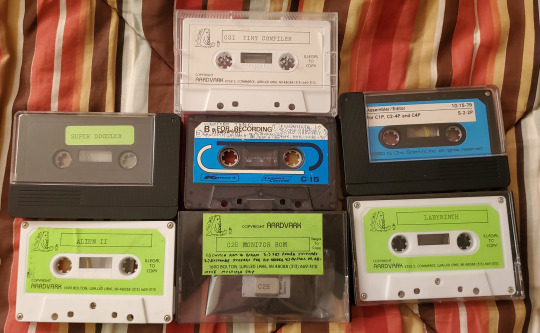
Talking with UK vs. US Commodore 64 users in particular will highlight the disparity in which storage mediums that were commonplace. I've got a few pieces of software on tape for mainly the VIC-20, but I rarely bother to use it, because it's slow and annoying. To be fair, Commodore's implementation of data storage on tape is pretty rock solid relative to the competition. It's considered more reliable than other company's but Chuck Peddle's implementation of the cassette routines are considered quite enigmatic to this day. He didn't document it super well, so CBM kept reusing his old code from the PET all the way through the end of the C128's development 7 years later because they didn't want to break any backward compatibility.

The big thing that really made alot of homebrewers and kit computer owners cozy up to the idea was the introduction of the Kansas City Standard from 1976. The idea of getting away from delicate and slow paper tape, and moving towards an inexpensive, portable, and more durable storage medium was quite enticing. Floppy disk drives and interfaces were expensive at the time, so something more accessible like off the shelf audio tapes made sense.
I've linked two places you can read about it from Byte Magazine's February 1976 issue below (check the attribution links).
You might recognize a familiar name present...
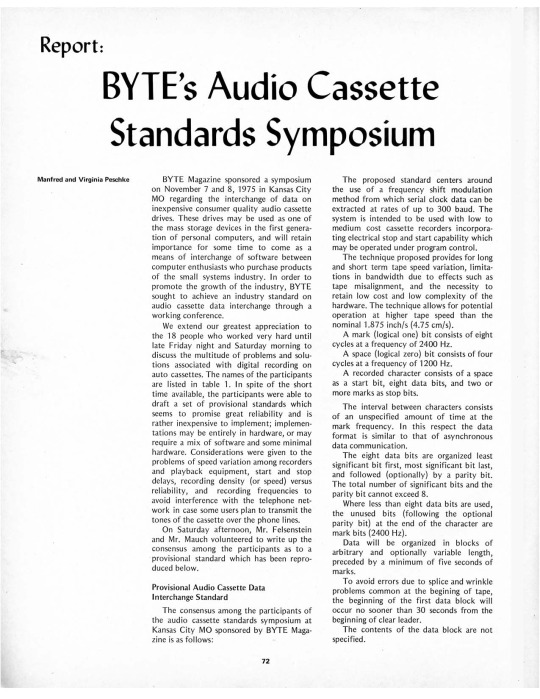
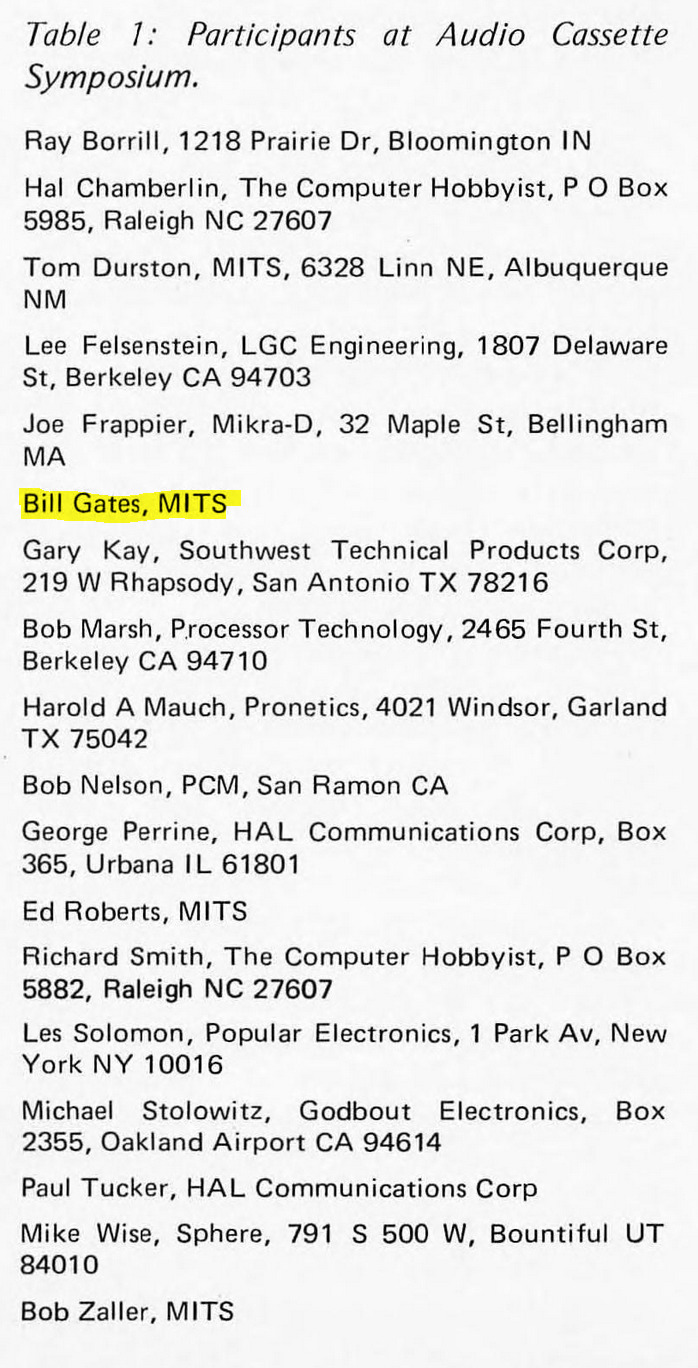
There are a few ways to encode binary data on tape designed to handle analog audio, but the KCS approach is to have 1's be 8 cycles of 2400Hz tone, and 0's be 4 cycles of 1200Hz tone. I say cycles, because while 300 baud is the initial specification, there is also a 1200 baud specification available, so the duration of marks vs spaces (another way of saying 1's and 0's), is variable based on that baud rate. Many S-100 computers implemented it, as do a few contemporary proprietary designs.
The big 3 microcomputers of 1977 that revolutionized the industry (Apple II, Commodore PET 2001, and Tandy TRS-80 Model I) each have their own cassette interface implementation. It kept costs down, and it was easy to implement, all things considered. The Apple II and TRS-80 use off-the-shelf cassette deck connections like many other machines, whereas the original variant of the PET had an integrated cassette. Commodore later used external cassette decks with a proprietary connector, whereas many other companies abandoned tape before too long. Hell, even the original IBM PC has a cassette port, not that anybody bothered to use that. Each one used a different encoding format to store their data, rather than KCS.
Here's a sample of what an OSI-formatted tape sounds like.
And here's a Commodore formatted tape, specifically one with VIC-20 programs on it.
I won't subject you to the whole program, or we'd be here all day. The initial single tone that starts the segment is called the "leader", I've truncated it for the sake of your ears, as well as recorded them kinda quietly. I don't have any other tape formats on hand to demonstrate, but I think you get the idea.
You can do alot better than storing programs on tape, but you can also do alot worse -- it beats having to type in a program every time from scratch.
273 notes
·
View notes
Text
A grant to study linguistic differences between Hebrew and English was flagged as an example of “woke DEI grants” in a new database released by Sen. Ted Cruz.
The database is part of ongoing Republican efforts to justify significant cuts to federal research funding and diversity programs under President Donald Trump.
The $226,000 grant, given by the National Science Foundation to the University of Massachusetts Amherst in 2022, was flagged by the Texas Republican senator’s team as having an inappropriate focus on “gender.”
But according to the description of the research in Cruz’s own database, the sole mention of gender in the grant’s description is in reference to the fact that the Hebrew language (like many) assigns gender to nouns.
The UMass grant was also one of seven in Cruz’s database of Biden-era grants that stated an intent to promote partnerships between American and Israeli research institutions — something that did not appear to mitigate opposition from Cruz, an avowed supporter of Israel. He said in a statement that the more than 3,400 grants in his database demonstrated that the NSF had funded “questionable projects that promoted Diversity, Equity, and Inclusion (DEI) or advanced neo-Marxist class warfare propaganda.”
A request for comment to Cruz’s office was not returned; nor was an inquiry sent to UMass. Cruz, the chair of the Senate committee on Commerce, Science & Transportation, said in a statement that his data “exposes how the Biden administration weaponized federal agencies to push a far-left ideology.”
He added, “Congress must end the politicization of NSF funding and restore integrity to scientific research.”
The public database of grants compiled by Cruz provides a window into how Trump and his allies are thinking about cuts to research funding. The flagged grants mentioning Israel were made to six universities including Brown, the University of Michigan and the University of Maryland-Baltimore County. They cover a range of scientific topics, from studying cognition to magnetic technologies to energy storage.
What they have in common is a stated intent to collaborate with an Israeli university. For example, Michigan’s grant specifically references a partnership with Ben-Gurion University in the southern Israeli city of Beersheva, while a second UMass grant mentions partnering with Technion-Israel Institute of Technology in the port city of Haifa, as well as “outreach by the Israeli collaborator to local high schools in Haifa.”
The second common thread among the Israel-related grant descriptions is the use of keywords flagged by the database as related to gender or DEI. Cruz’s team sorted the grants based on the presence of keywords related to the categories of “gender,” “status,” “social justice,” “race” and “environmental justice.”
None of the grants to mention Israeli partnerships make such topics the focus of their research, though some state a general commitment to “groups underrepresented in science” or “outreach to women and underrepresented minorities.” UMBC’s grant states that it will allow participation “for local high school students from underrepresented groups on the US side, and from various nationalities on the IL [Israeli] side.”
The UMass grant exploring the Hebrew and English languages makes no such commitment to diversity. Its reference to gender comes as it states that “English and Hebrew differ in how they organize the words within sentences and whether they assign gender to nouns; Hebrew assigns masculine and feminine genders to nouns, similar to languages like Spanish and French but unlike English.”
The project’s stated focus is to study how such linguistic differences affect “interpretation errors” among people who speak both languages.
Cruz’s dragnet of so-called “woke” research grants also comes as a number of American researchers and campus groups have pushed for boycotts of all Israeli institutions, in protest of Israel’s war in Gaza.
The database was posted as Elon Musk’s Department of Government Efficiency has targeted federal research funding on the basis of keywords that, the Trump team claims, reveal evidence of gender- and DEI-driven agendas. On Tuesday a federal judge intervened to block steep cuts to medical research funding at the National Institutes of Health. Another injunction blocked key parts of Musk’s effort to shut down the U.S. Agency for International Development.
A report last week in the Washington Post found that NSF staff were also being directed to comb through their research projects in search of dozens of offending keywords, including “women,” “victims,” “trauma” and “ethnicity.” Such efforts are part of a larger slashing of federal spending, including the shuttering of entire departments, that scholars say is unlawful and may be leading to a constitutional crisis.
39 notes
·
View notes
Text




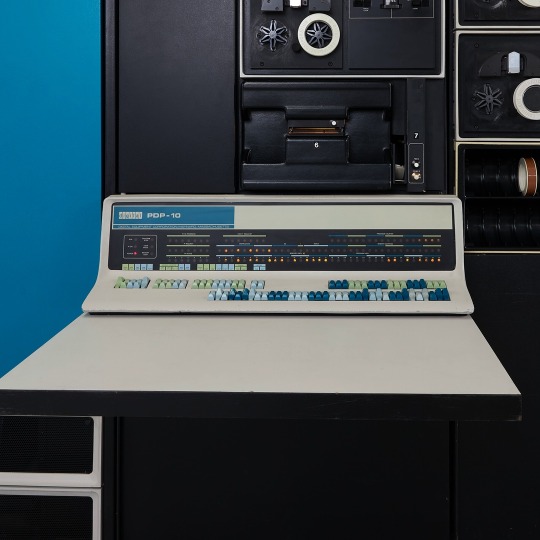

🎄💾🗓️ Day 11: Retrocomputing Advent Calendar - The SEL 840A🎄💾🗓️
Systems Engineering Laboratories (SEL) introduced the SEL 840A in 1965. This is a deep cut folks, buckle in. It was designed as a high-performance, 24-bit general-purpose digital computer, particularly well-suited for scientific and industrial real-time applications.
Notable for using silicon monolithic integrated circuits and a modular architecture. Supported advanced computation with features like concurrent floating-point arithmetic via an optional Extended Arithmetic Unit (EAU), which allowed independent arithmetic processing in single or double precision. With a core memory cycle time of 1.75 microseconds and a capacity of up to 32,768 directly addressable words, the SEL 840A had impressive computational speed and versatility for its time.
Its instruction set covered arithmetic operations, branching, and program control. The computer had fairly robust I/O capabilities, supporting up to 128 input/output units and optional block transfer control for high-speed data movement. SEL 840A had real-time applications, such as data acquisition, industrial automation, and control systems, with features like multi-level priority interrupts and a real-time clock with millisecond resolution.
Software support included a FORTRAN IV compiler, mnemonic assembler, and a library of scientific subroutines, making it accessible for scientific and engineering use. The operator’s console provided immediate access to registers, control functions, and user interaction! Designed to be maintained, its modular design had serviceability you do often not see today, with swing-out circuit pages and accessible test points.
And here's a personal… personal computer history from Adafruit team member, Dan…
== The first computer I used was an SEL-840A, PDF:
I learned Fortran on it in eight grade, in 1970. It was at Oak Ridge National Laboratory, where my parents worked, and was used to take data from cyclotron experiments and perform calculations. I later patched the Fortran compiler on it to take single-quoted strings, like 'HELLO', in Fortran FORMAT statements, instead of having to use Hollerith counts, like 5HHELLO.
In 1971-1972, in high school, I used a PDP-10 (model KA10) timesharing system, run by BOCES LIRICS on Long Island, NY, while we were there for one year on an exchange.
This is the front panel of the actual computer I used. I worked at the computer center in the summer. I know the fellow in the picture: he was an older high school student at the time.
The first "personal" computers I used were Xerox Alto, Xerox Dorado, Xerox Dandelion (Xerox Star 8010), Apple Lisa, and Apple Mac, and an original IBM PC. Later I used DEC VAXstations.
Dan kinda wins the first computer contest if there was one… Have first computer memories? Post’em up in the comments, or post yours on socialz’ and tag them #firstcomputer #retrocomputing – See you back here tomorrow!
#retrocomputing#firstcomputer#electronics#sel840a#1960scomputers#fortran#computinghistory#vintagecomputing#realtimecomputing#industrialautomation#siliconcircuits#modulararchitecture#floatingpointarithmetic#computerscience#fortrancode#corememory#oakridgenationallab#cyclotron#pdp10#xeroxalto#computermuseum#historyofcomputing#classiccomputing#nostalgictech#selcomputers#scientificcomputing#digitalhistory#engineeringmarvel#techthroughdecades#console
31 notes
·
View notes